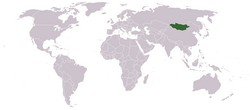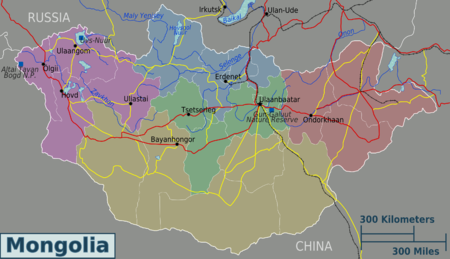 | |
| Location | |
 | |
| Ensign | |
 | |
| Basic information | |
| Capital | Ulaanbaatar |
| Goverment | Parliamentary Republic |
| Currency | Togrög/Tugrik (MNT) |
| Area | total: 1,565 million km2 country: 9,600 km2 soil: 1,555,400 km2 |
| Population | 2,791,272 (July 2006) |
| Language | Kalmuck Kazakh |
| Religion | Tibetan Buddhism 53%, Atheism 38.6%, Islam 3%, Shamanism 2.9%, Christianity 2.1% (2010) |
| Power system | 220V, 50 Hz (two round pins, European-style) |
| Phone number | 976 |
| Internet TLD | .mn |
| time zone | UTC 7 to 8 |
Mongolia[1] (Mongolian: онгол ) is a Central Asian country bordering Russia to the north and the People's Republic of China to the south, east and west. Although there is no common border with Kazakhstan but the westernmost point of Mongolia is only the easternmost point of Kazakhstan 38 kilometers (24 miles). This is the 19th largest country in the world and the second largest landlocked country in area, after Kazakhstan. With a large area but a population of only about 3 million people (2007), Mongolia becomes the country with the lowest population density on the planet. Much of Mongolia's land is uncultivable, mainly steppes, hills, and deserts. The capital and largest city of Mongolia is Ulan Bator, which is home to nearly 38% of the population.
overview
History
The land of Mongolia today has been inhabited by many ethnic groups since prehistoric times. They were mainly nomads and gradually developed into strong alliances. In 209 BC, the Xiongnu formed a powerful alliance under the leadership of King Mordon. They defeated the Dong Ho people, who had previously controlled eastern Mongolia, and quickly became a major force threatening China over the next three centuries. The Qin Dynasty had to build the Great Wall to prevent incursions from the north by the Xiongnu. After being defeated by the Chinese in 428-431, a portion of the Xiongnu moved westward and became the Huns. Later, the Rouran replaced the Xiongnu to rule the Mongols until they were defeated by the Tujue. The Tujue people ruled Mongolia in the 7th and 8th centuries. They were later replaced by the ancestors of the present-day Uyghurs, and later by the Khitans and Jurchens. In the 10th century, Mongolia was divided into many small tribes that were sporadically linked together. The Mongol Empire was founded by Genghis Khan in 1206 after uniting the Turkic-Mongolian tribes and then expanding. expansion into Eurasia, beginning with the invasion of Western Xia in northern China and the Khwarezm Empire in Persia. At its heyday, the Peace of Mongolia (the Silk Road of the Mongol Empire) facilitated cultural and trade exchanges between the East and the West during the 13th - 20th centuries. 14. At the time of Genghis Khan's death in 1227, the empire was divided among his four sons with the fourth son being the great khan, and by the 1350s, the Khan dynasty was fractured and disordered. the self that Genghis Khan brought. Eventually, the Khans diverged from each other, becoming the Yi Er khanate in Persia, the Chagatai khanate in Central Asia, the Golden Horde in present-day Russia, and the Yuan dynasty in China. Kingdom. After being defeated by the Han, the Mongols had to retreat to their own country and the Yuan dynasty continued to exist there, referred to by modern historians as the Northern Yuan Dynasty. The Ming Dynasty invaded Mongolia in 1380, and in 1388 won an important victory, Karakorum (Mongolian capital) was devastated, the Mongols were basically in the Ming vassal system. .Next, in the 17th century, the Mongols were strongly attacked by the Manchus (Nu Chan). In 1636, Mongolia became part of the Manchu empire. In 1911, the Qing Dynasty collapsed, Mongolia became an autonomous country from 1911 to 1919. On July 11, 1921, supported by the Soviet Union, the Mongolian People's Republic was born under (Socialist regime) ). Since 1990, due to the influence of the collapse of the Soviet Union, Mongolia began the process of democratization, economic and political reform, transitioning to a pluralistic and multi-party system with 18 officially active political parties, in which the Mongolian People's Party is the largest political party.
Geography and climate
With an area of 1,564,116 km² (603,909 mi²), Mongolia is the 19th largest country in the world, after Iran. This country is much larger than the next standing country PeruMongolia's geography is diverse with the Gobi Desert in the south and cold mountainous regions in the north and west. Much of Mongolia's territory consists of steppes. The highest peak in Mongolia is Mount Khüiten in the westernmost Tavan bogd massif at 4,374 m (14,350 ft). The Uvs Nuur Lake Delta, together with the Republic of Tuva in Russia, is a World Natural Heritage Site. Most of the country is hot in the summer and very cold in the winter, with average January temperatures dropping to just -30 °C (-22 °F). The country also experiences occasional spells of severe weather. harsh is called zud. Ulan Bator has the lowest average temperature of any other capital in the world. Mongolia is high, cold and windy. The country has an extreme continental climate with long, cold winters, short summers, and most of the year's rainfall also occurs in summer. The country averages 257 cloudless days per year, and is often in the center of an area of high atmospheric pressure. Precipitation is highest in the north (average 20 to 35 centimeters a year) and lowest in the south, with annual rainfall 10 to 20 centimeters. The southernmost inhabited area is the Gobi Desert, some areas where there is almost no rain for many years. The name "Gobi" is a Mongolian term for a desert steppe, often referring to a feature. of soils that don't have enough vegetation for marmots but enough for camels. The Mongols distinguish the Gobi from the actual desert, though the distinction is not always obvious to outsiders unfamiliar with the Mongolian landscape. The Gobi lands are fragile and vulnerable to overcrowding, leading to the expanse of the true desert, a useless rocky region where not even Bactrian camels can survive.
Politic
Currently, politics in Mongolia is multi-party, with 18 political parties operating together. The largest party is the Mongolian People's Party. Political structure with parliamentary democracy, the head of state is the president with a 4-year term. The current President, Mr. Tsakhiagiin Elbegdorj, was elected in May 2009. The current government of Mongolia is a coalition government, with a term of four years. The current Prime Minister is Mr. Sükhbaataryn Batbold.Mongolia is administratively divided into 21 provinces under central authority.
Region

| Central Mongolia including Ulan Bator and tourist areas Arkhangai |
| Eastern Mongolia |
| Gobi mostly desert regions of southern Mongolia |
| Northern Mongolia |
| Western Mongolia where the lake Uvs Nuur . is located |
City
Ulan Bator, the capital, the largest city.
Other destinations
Arrive
There are 4 gateways to Mongolia, 3 bordering Russia and 1 bordering China in Erlian.
Citizens of the following families can enter Mongolia visa-free:
up to 90 days:Kazakhstan, Kyrgyz, Georgia and Macau
up to 3 months:? USA
up to 30 days:Cuba, Israel, Malaysia, Thailand, Laos, Turkey and Japan
up to 21 days:Philippines
up to 14 days:Hong Kong, Singapore
By air
Genghis Khan International Airport in Ulan Bator.
By train
By car
By bus
By boat
Go
Language
The official language of Mongolia is Khalkha Mongolian, and is spoken by 90% of the population. Various dialects are spoken throughout the country. These dialects are included in the Mongolian languages. Mongolian is often included in the Altaic languages, a group of languages named after the Altay Mountains and also including the Turkic and Tungusic languages. Today, Mongolian is written in the Cyrillic alphabet. , although in the past it was written in Mongolian characters. A plan to reuse the old characters was planned in 1994, but has not yet taken place for various reasons. In the west of the country, Kazakh and Tuva languages, among other languages, are also spoken. Russian is the most commonly used foreign language in Mongolia, followed by English, although English has gradually replaced Russian as the second language.[citation needed] Korean has become popular because there are tens of thousands of Mongols working in South Korea. Interest in Chinese, the language of the neighboring power, has also increased. Japanese is also popular among young people. Some Mongolian educated and older people speak a little bit of language virtue, because they used to study in the East virtue old, while some speak languages belonging to the former Eastern Bloc countries. In addition, many young Mongolians are fluent in Western European languages because they studied and worked in those countries. virtue, France and Italy. Deaf people in Mongolia use Mongolian sign language.
